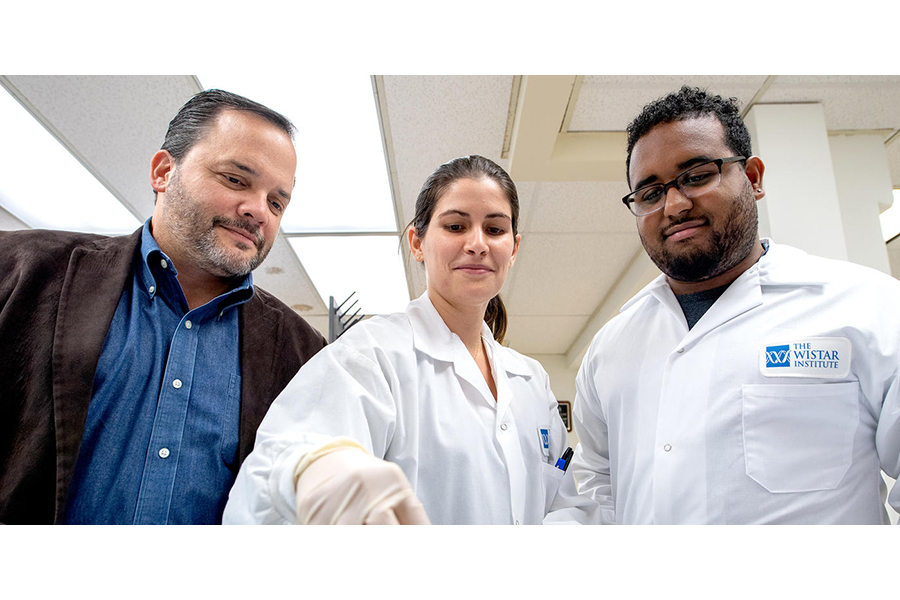The National Institute on Drug Abuse, a branch of the National Institutes of Health, has awarded more than $12 million to West Philadelphia-based biomedical research group The Wistar Institute to study the overlapping impact of HIV and addiction treatments.
The funds will form an international, multidisciplinary clinical research consortium with French, Vietnamese and U.S. brainpower, spearheaded by Wistar’s HIV Research Program. Two studies make up the “AMOHI program,” which stands for anti-retroviral therapy, medications of opioid use disorder, opioids and HIV infection. Both will evaluate the impact of methadone, suboxone and naltrexone — prescriptions used in medication-assisted recovery from opioid addiction — on people who also have HIV and use antiretroviral therapy.
“We came across the observation that one of these drugs may actually compete against the benefit that anti-retroviral therapy is expected to have,” said Luis Montaner, study leader and director of Wistar’s IV-1 Immunopathogenesis Laboratory, “and thus may maintain a detrimental situation that the individual will eventually succumb to other conditions based on that lack of benefits from antiretroviral therapy.”
Both HIV and chronic exposure to opioids cause activation in the immune system, the Wistar scientist explained, which leads to T-cell depletion and progression to AIDS. Medication-assisted recovery either blocks or activates opioid receptors in the brain, depending on whether a person uses methadone, suboxone or naltrexone. The researchers are investigating whether either medication essentially creates a “domino effect” by thwarting the body’s attempts to recover from HIV.
“If you have somebody that’s starting anti-retroviral therapy with the expectation that they will recover … but you already have a separate activity that is compromising the movement, then you may not be able to recover that insult from HIV as efficiently,” Montaner told PGN. “You have something else that’s actually actively acting against the recovery.”
The studies will occur over five years.
In the first, AMOHI-1, 225 people with HIV and addiction will simultaneously begin antiretroviral therapy and medication-assisted recovery. One-third of participants will be randomly assigned to each methadone, suboxone and naltrexone. Researchers will evaluate immune recovery one year later.
“At that point, you would have direct proof that the choice [people in recovery] make is going to have a dramatic impact on the ability of therapy to give you the benefit that will keep you alive longer,” Montaner said.
A $8,373,891 grant fuels the AMOHI1 study, which will take place in Vietnam. The country’s Ministry of Health, the Perelman School of Medicine at the University of Pennsylvania, the French-led Institute of Applied Medicine and Epidemiology and the New York-based Pasteur Institute will collaborate on the effort.
AMOHI-2, which received $3,889,138 of the grant funding, will play out in Philadelphia. Researchers will test the hypothesis that HIV is more persistent in people in medication-assisted recovery who use methadone, an opioid agonist, than naltrexone, an antagonist.
According to data from the Department of Public Health, 1,217 overdose deaths occurred in Philadelphia in 2017 and 1,116 last year. A 2019 report by the health care foundation Commonwealth Fund found Pennsylvania has the third-highest rate of overdose deaths in the nation.
In response, the Philadelphia nonprofit Safehouse is pushing for a supervised injection site in the city as a harm reduction method — a project that has been met by a hefty legal fight. This month, a federal judge ruled the facility did not violate U.S. law.
Montaner said he believes the findings from the AMOHI studies will help manage the opioid crisis taking place across the city. The research is important because interaction with HIV-combatting medicines is not a factor currently considered when prescribing a person in medication-assisted recovery a remedy to use, he added.
“If we can find out what are the best choices that people should make … Philadelphia is going to be one of the places that’s going to be benefitting from that information,” Montaner added.
